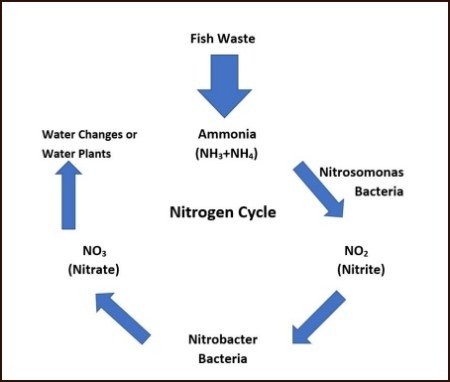| Back to Back Issues Page |
 |
|
The Goldfish Gazette, Issue #107 Aquarium Cycling Myths November 28, 2022 |
Goldfish Care TipsA Free Monthly Resource For Goldfish Enthusiasts In This Issue Despite all the information available on the Internet about the nitrogen cycle and how it works, some aquarists still believe water changes can crash an aquarium’s cycle. Aquarium Cycling Myths
Below are common myths about the nitrogen cycle. Nitrogen Cycling MythsMyth one: Too many water changes will crash the nitrogen cycle.Water changes don’t crash an aquarium’s nitrogen cycle because it is in the filter where the cycling takes place, not in the aquarium where there are few beneficial bacteria residing. Myth two: Once a filter is cycled, the aquarium can be fully stocked. This depends on the amount of ammonia-producing material that was added during the early stages of the cycle. If you used one small fish in the aquarium as the ammonia source, the filter bacteria level will only support that one fish. The fish population should only be increased slowly, with constant testing for ammonia after more fish are added. Myth three: Filter foam must be thoroughly cleaned regularly. Yes, the filter foam must be cleaned if the water flow has dropped below the required rate, but the brown gunk in the foam is the bacteria colony, not dirt and feces from the aquarium. Myth four: The nitrogen cycle is completed in two-three weeks. New tank syndrome usually occurs 2-3 weeks after an aquarium has been set up. It is caused by an ammonia spike. The filter still has to go through the nitrite and nitrate stages before fish can be safely introduced. Water temperature also plays a large part in how long a filter takes to go through the cycle. Myth five: By using a shop-bought product that introduces large quantities of beneficial bacteria into the aquarium, the aquarium can be stocked immediately. Not so. If you read the instructions on the products, they state it speeds up the cycling process, they don’t claim it provides the required numbers of bacteria needed immediately. Myth six: A good pH reading will indicate that the cycle is completed. Again, not so. In fact, a good pH level is necessary as low pH inhibits cycling. The pH should be above 7.0 and must be above 6.5, with the ideal pH being between 7.4 to 7.8. Myth seven: Green or cloudy water needs to be changed. A water change at this time removes the beneficial bacteria food source and stops the cycle. Myth eight: Nitrates are safe. Nitrates are much safer than ammonia and nitrites, to a point. It was once believed that nitrate levels of 200 ppm (parts per million) and above were safe. This is now known not to be the case, and anything above 30 ppm is considered unsafe for Goldfish, particularly for fancy varieties. Water Test kitsI was communicating on Facebook recently with an aquarist who felt his fish were stressed. He included a video of his aquarium.The 20 gallon aquarium contained 17 2-3 inch (50-75mm) fish, with several showing clamped fins. It had been set up for one week. After stating the obvious about fish numbers, I asked what were the water parameters. He showed me a pH test indicating a reading of 7.6. He didn’t have a nitrate or ammonia test kit. I asked if the filter was cycled, and he answered yes. I found it hard to believe an aquarium that had been set up for a week, had a filter that could support 17 fish in 20 gallons. I suspect the aquarium was experiencing an ammonia spike. If you don’t have a water test kit that can measure pH, ammonia and nitrate levels you really are flying blind.
Comments? Ideas? Feedback? I'd love to hear from you. Just reply to this e-zine and tell me what you think, or what topics you want to be covered. Next Month's Topic The ammonia testwww.facebook.com/aboutgoldfish |
| Back to Back Issues Page |
